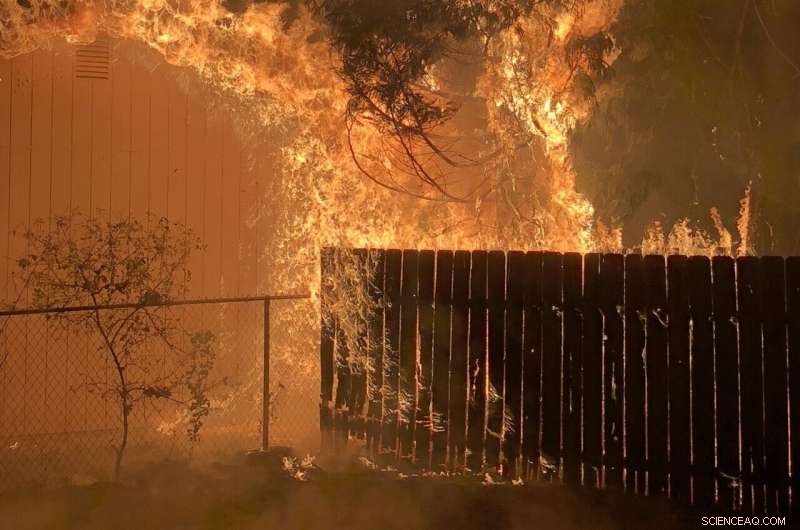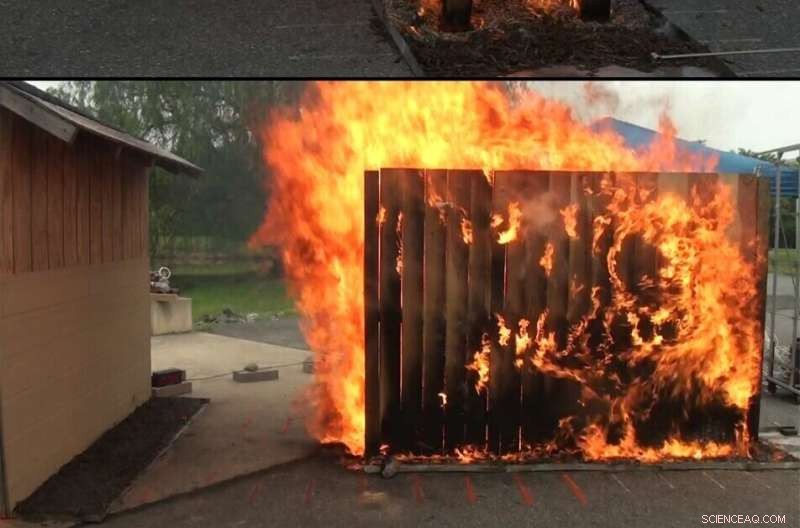
Recinzioni e pacciame contribuiscono comunemente alla diffusione degli incendi nelle comunità dell'interfaccia tra terre selvagge e urbane (WUI). Questa foto ritrae le fiamme che si sono propagate da una recinzione in fiamme a un edificio a circa 1,8 metri (6 piedi) di distanza durante il Camp Fire del 2018. Credito:CAL FIRE
Quando costruiscono recinzioni e abbelliscono le loro proprietà, i proprietari di case dovrebbero tenere la sicurezza antincendio in cima alle loro menti, specialmente se vivono in una regione soggetta a incendi, secondo un nuovo studio.
In quasi 200 esperimenti sul fuoco, i ricercatori del National Institute of Standards and Technology (NIST) hanno bruciato recinzioni residenziali e letti di pacciame per esaminare il ruolo che svolgono nella diffusione del fuoco. Hanno scoperto che il rischio di incendio era generalmente sproporzionatamente maggiore quando gli oggetti combustibili bruciavano insieme. Le fiamme si sono precipitate lungo il pacciame che fiancheggiava la base delle recinzioni e gli inferni hanno rapidamente inghiottito coppie di recinzioni quando sono bruciate in stretta vicinanza l'una all'altra. Al contrario, le recinzioni autonome prive di pacciame o detriti bruciavano a un ritmo molto più lento. Sulla base delle loro scoperte, gli autori del rapporto hanno raccomandato ai proprietari di case di non posizionare due recinzioni una dopo l'altra, di tenere distanti altre superfici combustibili e di intraprendere altre importanti azioni.
Gli incendi possono diffondersi rapidamente attraverso e potenzialmente sopraffare le comunità adiacenti alla natura selvaggia, la cosiddetta interfaccia wildland-urban (WUI). Gli studi post-incendio, compreso lo studio del NIST sul Camp Fire del 2018, hanno individuato recinzioni e pacciame come colpevoli della propagazione del fuoco.
"Le recinzioni che prendono fuoco spesso erano completamente scomparse. Se guardi da vicino, potresti vedere alcuni chiodi e viti rimasti. Quelli che abbiamo visto parzialmente bruciati sono stati lasciati in piedi perché sono stati difesi da qualcuno", ha detto il coautore del rapporto Alexander Maranghides, che è a capo dello studio Camp Fire del NIST. "Queste cose non si mettono fuori gioco."
Recinzioni e pacciame possono fungere da ponti per consentire alle fiamme di raggiungere gli edifici e da rampe di lancio per le braci in aria per accendere fuochi lontani, ma i codici antincendio negli Stati Uniti non affrontano il modo in cui dovrebbero essere installati e mantenuti e esistono poche indicazioni per aiutare i proprietari di case.
Per aiutare a costruire una base tecnica per lo sviluppo di linee guida in futuro, gli autori del nuovo rapporto hanno cercato di studiare gli incendi di recinzioni e pacciame in condizioni più vicine alla vita reale rispetto a quelle utilizzate negli studi precedenti.
Il team di ricerca ha bruciato recinzioni, letti di pacciame e combinazioni di entrambi all'aperto, accendendo i materiali diversi metri sottovento da una macchina eolica utilizzata per simulare condizioni reali di propagazione del fuoco. Sottovento al fuoco, la squadra ha allestito un capannone o un letto di pacciamatura come bersaglio.
Attraverso 187 esperimenti, hanno bruciato combustibili da soli e in combinazione, comprese recinzioni di diversi modelli comuni in legno, vinile o compositi legno-plastica e letti di pacciamatura composti da legno duro sminuzzato, pepite di corteccia di pino, paglia di pino o gomma.
I ricercatori hanno catturato filmati delle fiamme per misurare la velocità e il modello di propagazione della fiamma e per registrare la frequenza con cui le braci hanno acceso il capannone bersaglio. They also conducted research in the lab to measure how quickly samples of fence raw materials released heat.
Taking all the data together, the authors categorized the relative fire threat level for the various test conditions.
"In the highest hazard category, the fences and mulch are going to carry the fire along toward your house in a matter of a few minutes, not hours," said NIST physicist Kathryn Butler, co-lead author of the report.

An experiment wherein NIST researchers burned two privacy fences separated by 46 centimeters (18 inches), sitting on top of mulch, demonstrates the danger of placing fences back to back. In less than four minutes after ignition, the fences were entirely engulfed in flames, which extended several feet beyond the fences. Credito:NIST
The most dangerous fires observed were those that had multiple sources of fuel burning at the same time. In the tests where mulch lined the bottom of a fence, fire tended to swiftly advance across the beds of fine combustibles, which served as rich sources of embers and allowed flames to quickly ignite the fence along its entire length.
The researchers learned that the fires could get much worse as well.
When two fences made of combustible materials were placed back to back—mimicking the scenario where two neighbors each put up a fence along their property lines—the most intense flames of the entire project erupted. After the fire was established, long-reaching flames quickly shot up, completely engulfing fence panels 2.4 meters (8 feet) long and 1.8 meters (6 feet) tall in as little as four minutes. Embers sparked fires on the target in almost every one of these tests.
"It's very well known that when you confine a fire on the sides, it's bad news. Keeping those hot gases between the fences with surfaces radiating intense heat to each other leads to explosive fire behavior," Butler said.
When fence panels burned alone, it was a different story. Flames slowly chewed away at the fences and did not spread very far during these experiments, with some progressing less than a meter (3.3 feet) in an hour. Although these fires burning slowly on a sole fuel source were less hazardous and more manageable, high winds that may accompany a wildfire could blow debris toward the fence, adding fuel to the fire.
Butler, NIST mechanical engineer Erik Johnsson and the rest of the authors crafted seven recommendations for homeowners living in WUI zones based on their analysis. The first recommendation is to avoid doubling up on fences completely, as the study found that fences as far apart as 91 centimeters (3 feet) still produced large flames. The second says that combustible fences should be placed where they will not interfere with exit routes.
Other recommendations advise keeping combustibles as far away from each other as possible, even between property lines, and clearing yards—and especially the space near or between fences—of debris, such as leaves or fallen branches.
The report also indicates that homeowners should replace combustible landscape features with those consisting of noncombustible material such as stone, steel or cement, when possible.
Because of the ever-present danger of embers during wildfires—even when there is a large distance between a structure and the fire—the researchers also urge homeowners to enhance their homes to resist ember ignition through a process called hardening. The detailed steps for hardening are described in a separate NIST report on mitigating wildfires.
The team members intend to keep pushing forward to cover new ground in wildfire research.
With additional experiments, they plan to offer additional insights on risk mitigation and eventually lay a groundwork for new guidance, standards and fire codes that could curb the real wildfire hazards that endanger life and property in the U.S.
The research was published as NIST Technical Note 2228 . + Esplora ulteriormente